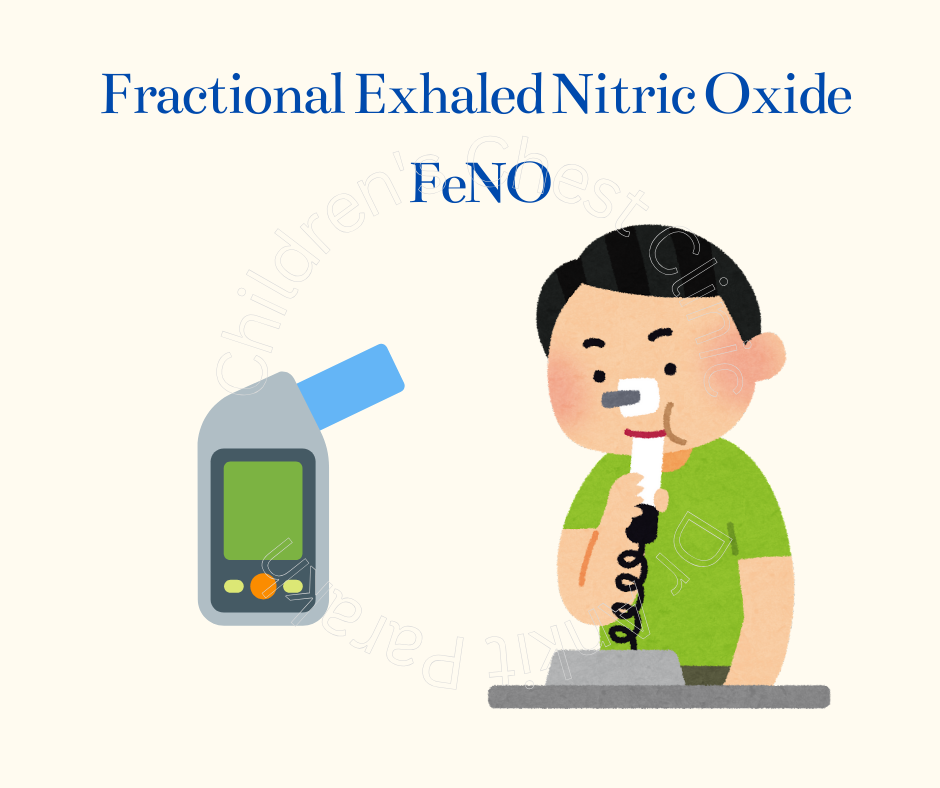
Fractional Exhaled Nitric Oxide (FeNO)
Fractional Exhaled Nitric Oxide (FeNO) is a non-invasive test that measures the level of nitric oxide (NO) in the breath. Nitric oxide is a gas produced by the cells in the airways, and elevated levels are often associated with airway inflammation, which is a hallmark of asthma. The FeNO test is used to assess inflammation in the lungs, particularly in individuals with asthma or those suspected of having it.
For children who are struggling with symptoms of asthma, such as wheezing, coughing, or shortness of breath, FeNO testing can provide valuable insights into the severity of airway inflammation, which helps guide treatment strategies.
How is FeNO Testing Performed?
The FeNO test involves a child exhaling into a small handheld device that measures the level of nitric oxide in the breath. It is a simple and painless procedure, typically taking only a few minutes. The results are available within minutes, offering a quick and efficient way for pediatric pulmonologists and allergists to evaluate the level of inflammation in the child’s airways.
How Does FeNO Help in Diagnosing Asthma in Children?
Asthma in children often presents with symptoms that overlap with other respiratory conditions, such as viral infections or allergies. Traditionally, asthma diagnosis relied heavily on the child’s medical history, physical examination, and spirometry (lung function tests). However, these methods may not always provide a clear picture, especially in younger children who may have difficulty performing the required tests.
FeNO testing offers several advantages:
- 1. Identifying Inflammation: Elevated FeNO levels are typically seen in children with asthma, particularly those who have allergic asthma, a type that is often triggered by allergens such as dust, pollen, or pet dander. FeNO can identify inflammation in the airways before it becomes clinically evident.
- 2. Monitoring Asthma Control: By measuring FeNO levels over time, doctors can assess whether asthma symptoms are being well-managed or if the child needs adjustments in their treatment regimen. For example, if FeNO levels remain high, it may indicate that inflammation is not well-controlled, even if the child feels fine.
- 3. Personalized Treatment Plans: FeNO testing allows for more tailored treatment plans. By understanding the level of airway inflammation, medication such as inhaled corticosteroids, can be adjusted more effectively, ensuring the child receives the optimal treatment for their specific condition.
- 4. Assessing Response to Medication: FeNO levels can be used to gauge how well a child is responding to prescribed medications. For instance, a decrease in FeNO levels after starting asthma medication often correlates with reduced inflammation and better asthma control.
Benefits of FeNO Testing in Pediatric Asthma Management
Non-invasive and Safe: Since FeNO testing involves breathing into a device, there’s no need for blood draws or other invasive procedures, making it a child-friendly option.
Early Detection: FeNO testing can detect asthma-related airway inflammation before clinical symptoms become more severe, allowing for earlier intervention and better management of asthma.
Cost-effective: The FeNO test is relatively inexpensive compared to some other diagnostic tools for asthma and is reimbursed by most insurance providers.
Accurate and Reliable: The test provides precise information about the level of inflammation, offering better insights than traditional methods that may rely solely on subjective symptom reports.
Risks and Safety Considerations
While drug challenge tests are generally safe, they do carry some risks, especially if the child has a history of severe allergies. In rare cases, a child may experience a severe allergic reaction during the test. However, these tests are performed in a controlled environment, and healthcare providers are well-equipped to handle emergencies.
Fractional Exhaled Nitric Oxide (FeNO) testing is a valuable tool for diagnosing and managing asthma in children. By providing quick and accurate information about airway inflammation, FeNO helps make more informed decisions regarding treatment. If your child has asthma or you suspect they may have asthma, consult with a pediatric pulmonologist to see if FeNO testing could be a beneficial addition to their care plan.
Conclusion
Fractional Exhaled Nitric Oxide (FeNO) Testing facilities at BLK MAX Hospital
BLK MAX hospital has a state-of-art Niox Vero equipment for estimation of Fractional Exhaled Nitric Oxide (FeNO) in children
Frequently Asked Questions (FAQs)
1. What is the normal range for FeNO levels in children?
A normal FeNO level in children is typically below 20 parts per billion (ppb). Higher levels suggest increased airway inflammation, which may indicate asthma or other inflammatory respiratory conditions.
2. Can FeNO testing be used to diagnose asthma in all children?
FeNO testing is most effective for children who have allergic asthma or asthma with a strong inflammatory component. It may not be as useful for diagnosing other types of asthma or non-inflammatory respiratory conditions.
3. Is FeNO testing useful for monitoring asthma control in children?
Yes, FeNO testing is an excellent tool for monitoring asthma control in children. If FeNO levels remain elevated despite treatment, it may indicate that the child’s asthma is not well-controlled and adjustments to their medication may be necessary.
4. Is the FeNO test safe for young children?
Yes, the FeNO test is completely non-invasive and safe for children of all ages. It is a simple test that requires the child to breathe out into a device, making it well-tolerated even by younger patients.
5. How frequently should FeNO testing be done in children with asthma?
The frequency of FeNO testing depends on the child’s asthma management plan. In general, FeNO testing is done periodically to monitor asthma control, typically every 3-6 months or whenever changes in treatment are considered.



